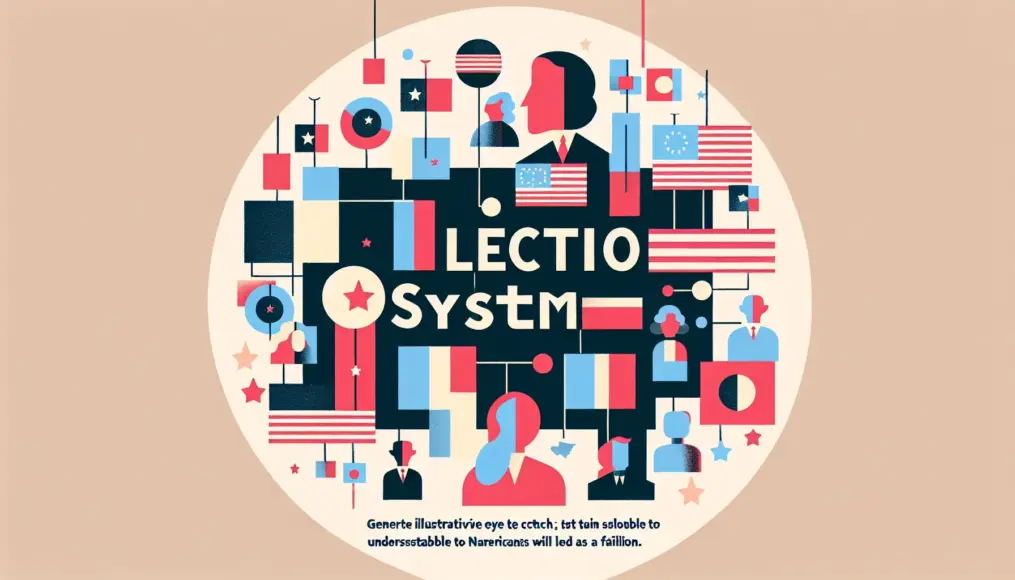The non-bound list proportional representation system is one of the most intriguing electoral mechanisms out there. This system aims to provide a clearer reflection of voter support for candidates and parties. But what are its actual characteristics? Moreover, it’s essential to explore the impact this system has on elections.
In this article, we’ll thoroughly examine the core concepts of the non-bound list proportional representation system, its historical background, how it differs from current electoral systems, and its influence on actual election outcomes. By the end of this read, you’ll gain a deeper understanding of electoral systems and develop a fresh perspective on your voting behavior.
- Key concepts and advantages of the non-bound list proportional representation system
- The background of its introduction in Japan and comparisons with other countries
- An analysis of how it differs from current electoral systems and its impacts
What is a Non-Bound Open List Proportional Representation System?
The Non-Bound Open List Proportional Representation system is a voting mechanism designed to more accurately reflect voter support for candidates and political parties during elections. Under this system, a list is created for each electoral district, and voters cast their votes not directly for candidates but for a party’s list. This allows each party to win seats in proportion to the number of votes they receive. A key feature of the non-bound open list system is that voters have the freedom to choose from among the candidates on the list. Let’s take a closer look at the basic concepts of this system.
Basic Concepts of the Non-Bound Open List System
The non-bound open list proportional representation system provides a framework where voters can freely select specific candidates. This allows voters to cast their votes based on the policies and ideologies of the parties. Specifically, candidates listed on the party’s roster are backed by the party but are elected based on voters’ choices. This system enables election results to reflect a broader range of opinions, enhancing political transparency.
Additionally, in a non-bound open list system, support for specific candidates influences seat allocation, allowing voters to express their opinions and desires more directly. This flexibility and diversity in the electoral system make the non-bound open list appealing.
- Voters can freely choose candidates
- Voting based on party policies is possible
- Enhances political transparency and diversity
Differences from Traditional Proportional Representation
While traditional proportional representation systems allocate seats to parties based on the vote counts in each district, there are several distinctions from the non-bound open list system. Firstly, in traditional proportional representation, voters cannot select candidates directly; they vote for the party instead. Consequently, individual candidates’ popularity and recognition have less impact on their election outcomes.
In contrast, the non-bound open list system allows voters to choose candidates from within the party’s list, making individual candidate support crucial. This difference means that election results can better reflect a wider array of opinions. Moreover, the non-bound open list system emphasizes not only the strength of the party but also the appeal of individual candidates.

If you found this article intriguing, you might also enjoy our piece on “Exploring Japan’s House of Representatives Election System: Its History and Impact.” This article delves into the historical background and evolution of Japan’s House of Representatives election system, considering the impact of electoral systems on society. Be sure to check it out to deepen your understanding of electoral processes!
- In traditional proportional representation, voters cannot directly select candidates
- In non-bound open lists, support for individual candidates is crucial
- The strength of parties and the appeal of candidates both influence election outcomes
The Historical Background of the Non-Bound List Proportional Representation System
The non-bound list proportional representation system plays a crucial role in modern electoral systems, but its introduction comes with a rich historical context. In Japan, this system was adopted as part of post-war political reforms. Understanding the evolution of electoral systems helps shed light on how the non-bound list proportional representation system was shaped and its current impact on politics. Let’s take a closer look at how this system was introduced in Japan.
The Introduction in Japan
Japan’s non-bound list proportional representation system was introduced in 1994. This change was part of a broader electoral reform aimed at shifting away from the previous medium-sized electoral district system. Under the medium-sized district system, candidates’ success heavily depended on local popularity and personal connections. In contrast, the non-bound list system provides a framework that better reflects party support rates.
Initially, the hope was that this system would accurately translate voter support for parties into legislative seats. This change was expected to bring a wider array of opinions and values into politics, contributing to the advancement of democracy. However, the system also comes with various challenges, and discussions about its actual impact on election results continue to this day.
- The non-bound list proportional representation system was introduced in Japan in 1994
- It was part of political reforms aimed at transitioning from the medium-sized electoral district system
- The expectation was to reflect diverse opinions in politics
Comparison with Other Countries
The non-bound list proportional representation system is not unique to Japan; it is also utilized in other countries, though the ways it is implemented and its effects can vary widely. For example, Sweden and the Netherlands employ proportional representation, where seat allocation is highly sensitive to election results. However, these countries have binding lists, which affects the degree of freedom candidates have in being selected, making their systems different from Japan’s.
In comparison to other countries, Japan’s non-bound list system is distinctive in that voters have the freedom to choose candidates. This flexibility allows not only for party support to be reflected but also for individual candidates’ popularity and policy endorsements to influence election outcomes, introducing diversity into the results. On the flip side, this freedom can intensify competition among candidates and complicate cooperation between parties.

If you found this article intriguing, you might also enjoy reading “Considering the Evolution and Impact of the Age of Candidacy.” This piece delves into the history of the age of candidacy and its implications, further enriching your understanding of electoral systems overall.
- Proportional representation is also adopted in Sweden and the Netherlands
- Other countries have binding lists, which changes the degree of freedom in candidate selection
- Japan’s system promotes diversity but may complicate cooperation between parties
Differences from the Current Electoral System
The non-binding proportional representation system has several key differences compared to traditional electoral systems. Understanding these differences is crucial, as they significantly impact electoral outcomes and voting behavior. In this section, we’ll explore the shortcomings of traditional electoral systems and delve into the advantages and disadvantages of the non-binding proportional representation system. This will provide a deeper insight into how changes in the electoral system can affect the political landscape.
Shortcomings of Traditional Electoral Systems
Traditional electoral systems, such as medium-sized district systems and single-member district systems, have faced numerous issues when it comes to candidate and party selection. One major problem is that voters tend to be heavily influenced by local popularity and regional ties when choosing candidates. As a result, politicians often prioritize local interests, which can lead to a neglect of policies that consider the national balance.
Moreover, traditional systems frequently fail to adequately represent minority opinions. While large political parties secure a significant number of seats, smaller parties and emerging movements have struggled to gain a foothold in legislative bodies. These issues have driven the push for the implementation of the non-binding proportional representation system.
- Traditional systems rely on local popularity and regional ties
- Politicians tend to favor local interests
- Minority opinions have difficulty being represented in legislative bodies
Advantages and Disadvantages of the Non-Binding Proportional Representation System
The non-binding proportional representation system was designed to address the shortcomings of traditional electoral systems. One of its main advantages is that it allows voters the freedom to choose candidates, making it easier for diverse opinions to be reflected in politics. This can lead to more fair and transparent electoral outcomes, while also encouraging politicians to consider policies from a national perspective.
However, the non-binding proportional representation system also has its drawbacks. As voters gain more freedom in selecting candidates, competition among candidates may intensify, potentially leading to an overly individualistic approach to elections. Additionally, the cohesion within political parties may weaken, making it challenging for parties to cooperate with one another, which could introduce instability into the political landscape.
- Diverse opinions are more likely to be reflected in politics
- Politicians are encouraged to adopt a national perspective
- Increased competition among candidates may weaken party cohesion
The Impact of Non-Bound List Proportional Representation on Elections
Non-bound list proportional representation aims to more accurately reflect voter support for candidates and parties during elections. Since its introduction, it’s essential to analyze how this system has influenced election outcomes and voter behavior based on actual data. In this section, we’ll explore the effects of non-bound list proportional representation on election results and the changes in voting behavior.
Analyzing Actual Election Results
Since the implementation of non-bound list proportional representation, we have observed significant changes in election results. Notably, the opportunities for diverse parties to secure seats have increased, thereby alleviating the dominance of traditional major parties. As a result, election outcomes are now more reflective of a wider range of opinions and values, which has been praised for enhancing political transparency.
Additionally, the characteristics of the non-bound list system have led to candidates’ personal appeal playing a larger role in election results. Voters are increasingly prioritizing candidates’ policies and personalities, which has shifted the support base for political parties. Analyzing election results is crucial for predicting future political trends.
- Increased opportunities for diverse parties to win seats
- Enhanced political transparency
- Candidates’ personal appeal influencing election results
Impact on Voting Behavior
The introduction of non-bound list proportional representation has also brought changes to voting behavior. Voters can freely choose candidates, making individual support as critical as party allegiance. This shift allows voters to select candidates that better align with their own opinions and values.
Moreover, the diversification of voting behavior has led to a decline in traditional fixed votes, resulting in a more competitive electoral landscape. Voters are now more focused on candidates’ policies and personalities, intensifying competition among them. These changes are prompting politicians to adopt new strategies, contributing to a dynamic political environment.

If you’re interested in this topic, check out our article “What Are the Impacts of a Unified Election System?.” It offers a multifaceted exploration of how electoral systems affect politics and society, detailing the changes in voting behavior and the pros and cons of system reforms. This insightful content encourages consideration of the potential for increased political participation, making it a valuable read.
- Increased diversity in voting behavior
- Decline in fixed votes, leading to competitive elections
- Greater emphasis on candidates’ policies and personalities
Conclusion
The non-partisan proportional representation system plays a vital role in Japan’s electoral landscape. This system allows voters the freedom to choose candidates, making it easier for diverse opinions to be reflected in politics. It aims to overcome the shortcomings of traditional electoral frameworks, leading to fairer and more transparent election outcomes. However, as voter freedom increases, new challenges have arisen, including intensified competition among candidates.
Through this article, I hope you’ve gained a deeper understanding of the fundamental concepts, historical context, and differences between this system and current electoral practices, as well as its impact on elections. I’m eager to see how this system will function and evolve in future political arenas.
- The non-partisan proportional representation system is designed to reflect diverse opinions.
- It was introduced to address the problems of traditional electoral systems.
- Increased voter freedom has intensified competition, leading to new challenges.
By reflecting further on this system, we can make our political participation more meaningful. I encourage you to share your thoughts and opinions in the comments. Your voice could influence the future of politics.



Comment